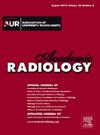基于多参数磁共振成像的放射组学分析预测胃癌淋巴结转移和生存结果:一项双中心研究
IF 3.8
2区 医学
Q1 RADIOLOGY, NUCLEAR MEDICINE & MEDICAL IMAGING
引用次数: 0
摘要
理由和目的:胃癌(GC)具有高度异质性,术前准确评估淋巴结状态仍具有挑战性。我们旨在开发一种基于多参数磁共振成像的胃癌淋巴结转移(LNM)预测模型,并探讨其对预后的影响:在这项双中心回顾性研究中,479 名 GC 患者在根治性胃切除术前接受了术前多参数 MRI 检查。分别从 T2 加权成像、表观弥散系数图和对比增强 T1 加权成像(cT1WI)中提取了 1595 个成像特征。特征选择步骤包括博鲁塔算法和模拟退火算法,以确定关键特征。基于单序列和多序列构建了不同的放射组学模型(RM)。从鉴别、校准和临床实用性方面评估了各种 RM 在预测 LNM 方面的性能。此外,还采用 Kaplan-Meier 生存曲线来估计无病生存期(DFS)和总生存期(OS)的差异:结果:多序列放射组学模型(MRM)在训练队列和两个验证队列中的曲线下面积(AUC)分别为0.774[95%置信区间(CI),0.703-0.845]、0.721(95% CI,0.593-0.850)和0.720(95% CI,0.639-0.801),优于单序列RM。值得注意的是,与其他两个单序列模型相比,由 cT1WI 导出的 RM 表现出更优越的性能。此外,所提出的 MRM 与 GC 患者的 DFS 和 OS 有显著相关性(均为 P 结论):基于原发病灶的多参数 MRI 放射组学模型在预测 GC 患者的 LNM 和生存结果方面表现出中等水平的性能,可为个性化治疗策略提供有价值的见解。本文章由计算机程序翻译,如有差异,请以英文原文为准。
Multiparametric MRI-based Radiomics Analysis for Prediction of Lymph Node Metastasis and Survival Outcome in Gastric Cancer: A Dual-center Study
Rationale and Objectives
Gastric cancer (GC) is highly heterogeneous, and accurate preoperative assessment of lymph node status remains challenging. We aimed to develop a multiparametric MRI-based model for predicting lymph node metastasis (LNM) in GC and to explore its prognostic implications.
Materials and Methods
In this dual-center retrospective study, 479 GC patients undergoing preoperative multiparametric MRI before radical gastrectomy were enrolled. 1595 imaging features were extracted from T2-weighted imaging, apparent diffusion coefficient maps, and contrast-enhanced T1-weighted imaging (cT1WI), respectively. Feature selection steps, including the Boruta and Simulated Annealing algorithms, were conducted to identify key features. Different radiomics models (RMs) based on the single- and multiple-sequence were constructed. The performance of various RMs in predicting LNM was assessed in terms of discrimination, calibration, and clinical usefulness. Additionally, Kaplan-Meier survival curves were employed to estimate differences in disease-free survival (DFS) and overall survival (OS).
Results
The multi-sequence radiomics model (MRM) achieved area under the curves (AUCs) of 0.774 [95 % confidence interval (CI), 0.703–0.845], 0.721 (95 % CI, 0.593–0.850), and 0.720 (95 % CI, 0.639–0.801) in the training and two validation cohorts, respectively, outperforming the single-sequence RMs. Notably, the RM derived from cT1WI demonstrated superior performance compared to the other two single-sequence models. Furthermore, the proposed MRM exhibited a significant association with DFS and OS in GC patients (both P < 0.05).
Conclusion
The multiparametric MRI-based radiomics model, derived from primary lesions, demonstrated moderate performance in predicting LNM and survival outcomes in patients with GC, which could provide valuable insights for personalized treatment strategies.
求助全文
通过发布文献求助,成功后即可免费获取论文全文。
去求助
来源期刊

Academic Radiology
医学-核医学
CiteScore
7.60
自引率
10.40%
发文量
432
审稿时长
18 days
期刊介绍:
Academic Radiology publishes original reports of clinical and laboratory investigations in diagnostic imaging, the diagnostic use of radioactive isotopes, computed tomography, positron emission tomography, magnetic resonance imaging, ultrasound, digital subtraction angiography, image-guided interventions and related techniques. It also includes brief technical reports describing original observations, techniques, and instrumental developments; state-of-the-art reports on clinical issues, new technology and other topics of current medical importance; meta-analyses; scientific studies and opinions on radiologic education; and letters to the Editor.
 求助内容:
求助内容: 应助结果提醒方式:
应助结果提醒方式:


